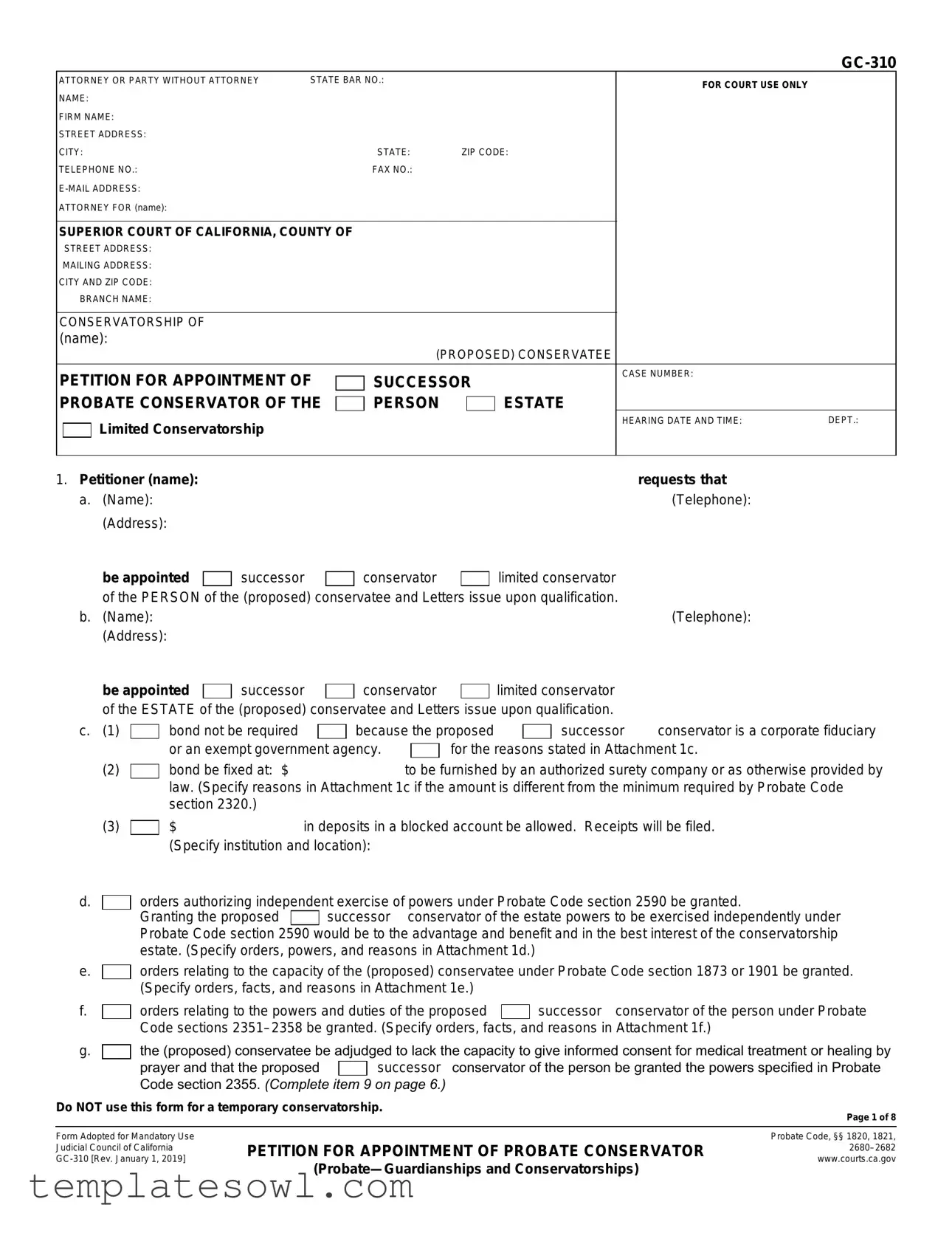What is the GC-310 form?
The GC-310 form is a petition used in California courts for the appointment of a successor conservator. It is necessary when someone cannot manage their personal or financial affairs due to incapacity. The form outlines the request to appoint a new conservator, detail the reasons for the appointment, and specify the powers and responsibilities involved.
Who can file the GC-310 form?
The form can be filed by an interested person, such as a family member, friend, or professional fiduciary. The petitioner may also be the proposed conservatee or spouse of the conservatee. If a professional fiduciary is involved, additional information about their qualifications must be included.
What information is required in the GC-310 form?
The form requires several key details including information about the petitioner, the proposed conservatee, the reason for the conservatorship, and any property involved. The petitioner needs to state their relationship to the proposed conservatee and provide a brief description of the conservatee's condition and needs.
What types of conservatorships does the GC-310 address?
The GC-310 form is applicable for both general and limited conservatorships. A general conservatorship covers broader powers over personal and financial matters, while a limited conservatorship restricts the authority of the conservator to specific areas, such as decisions about medical treatment or financial management.
Is there a filing fee for the GC-310 form?
Yes, there is typically a filing fee associated with submitting the GC-310 form. The amount can vary by county. Fee waivers may be available for those who qualify based on financial need.
What happens after the GC-310 form is filed?
Once the GC-310 form is filed with the court, a hearing will be scheduled. Notices will be sent to interested parties. During the hearing, the court will review the petition, hear any objections, and determine if the appointment of the successor conservator is in the best interest of the proposed conservatee.
Can a conservatorship be contested?
Yes, a conservatorship can be contested by interested parties. They can file objections to the appointment, which will be considered during the court hearing. It's important for all parties to present their arguments clearly to the court.
What is the significance of attachments in the GC-310?
Attachments are used to provide additional information and support for the petition. They can include details about the conservatee’s needs, property values, and any past relationships between the petitioner and the conservatee. These documents help the court understand the full context of the situation.
How should the completed GC-310 form be filed?
The completed GC-310 form should be filed with the appropriate court in California. Petitioner’s may submit the form in person or, in some cases, electronically. It’s important to ensure that all required signatures and attachments are included before submission.





 successor conservator of the estate powers to be exercised independently under Probate Code section 2590 would be to the advantage and benefit and in the best interest of the conservatorship estate.
successor conservator of the estate powers to be exercised independently under Probate Code section 2590 would be to the advantage and benefit and in the best interest of the conservatorship estate.  successor conservator of the person be granted the powers specified in Probate Code section 2355.
successor conservator of the person be granted the powers specified in Probate Code section 2355. 



 orders authorizing placement or treatment for a major neurocognitive disorder (such as dementia) as specified in the
orders authorizing placement or treatment for a major neurocognitive disorder (such as dementia) as specified in the  other orders be granted.
other orders be granted. 

 a resident of this county.
a resident of this county.
 not a resident of this county, but commencement of the conservatorship in this county is in the best interests of the proposed conservatee for the reasons specified in Attachment 3a.
not a resident of this county, but commencement of the conservatorship in this county is in the best interests of the proposed conservatee for the reasons specified in Attachment 3a.
 is temporarily living in this county, or
is temporarily living in this county, or
 has property in this county, or
has property in this county, or
 commencement of the conservatorship in this county is in the best interest of the proposed conservatee for the reasons specified in Attachment 3a.
commencement of the conservatorship in this county is in the best interest of the proposed conservatee for the reasons specified in Attachment 3a.
 is the spouse of the (proposed) conservatee.
is the spouse of the (proposed) conservatee.  is the domestic partner or former domestic partner of the (proposed) conservatee.
is the domestic partner or former domestic partner of the (proposed) conservatee.  is a relative of the (proposed) conservatee as
is a relative of the (proposed) conservatee as  is an interested person or friend of the (proposed) conservatee.
is an interested person or friend of the (proposed) conservatee. is a state or local public entity, officer, or employee.
is a state or local public entity, officer, or employee. is the guardian of the proposed conservatee.
is the guardian of the proposed conservatee. is a professional fiduciary within the meaning of Business and Professions Code section 6501(f) who is licensed by the Professional Fiduciaries Bureau of the Department of Consumer Affairs. Petitioner's license number is provided in item 1 on page 1 of the attached Professional Fiduciary Attachment.
is a professional fiduciary within the meaning of Business and Professions Code section 6501(f) who is licensed by the Professional Fiduciaries Bureau of the Department of Consumer Affairs. Petitioner's license number is provided in item 1 on page 1 of the attached Professional Fiduciary Attachment. 



 the spouse of the (proposed) conservatee.
the spouse of the (proposed) conservatee. 
 the domestic partner or former domestic partner of the (proposed) conservatee.
the domestic partner or former domestic partner of the (proposed) conservatee. 
 a relative of the (proposed) conservatee as
a relative of the (proposed) conservatee as 
 a nonprofit charitable corporation that meets the requirements of Probate Code section 2104.
a nonprofit charitable corporation that meets the requirements of Probate Code section 2104. a professional fiduciary, as defined in Business and Professions Code section 6501(f). His or her statement concerning licensure or exemption is provided in item 1 on page 1 of the attached
a professional fiduciary, as defined in Business and Professions Code section 6501(f). His or her statement concerning licensure or exemption is provided in item 1 on page 1 of the attached  other
other 
 Engagement and prior relationship with petitioning professional fiduciary
Engagement and prior relationship with petitioning professional fiduciary 
 Statements of who engaged petitioner, or how petitioner was engaged to file this petition, and a description of any prior relationship petitioner had with the (proposed) conservatee or his or her family or friends, are provided in item 2 on page 2 of the attached
Statements of who engaged petitioner, or how petitioner was engaged to file this petition, and a description of any prior relationship petitioner had with the (proposed) conservatee or his or her family or friends, are provided in item 2 on page 2 of the attached  per Inventory and Appraisal identified in item (1).
per Inventory and Appraisal identified in item (1).
 estimated value.
estimated value.
 is receiving or entitled to receive
is receiving or entitled to receive  is neither receiving nor entitled to receive
is neither receiving nor entitled to receive


 is an adult.
is an adult.
 will be an adult on the effective date of the order
will be an adult on the effective date of the order  is a married minor.
is a married minor. is a minor whose marriage has been dissolved.
is a minor whose marriage has been dissolved.



 Confidential Supplemental Information
Confidential Supplemental Information  The (proposed) conservatee's spouse is not a party to any action or proceeding against the (proposed) conservatee for legal separation, dissolution of marriage, annulment, or adjudication of nullity of their marriage.
The (proposed) conservatee's spouse is not a party to any action or proceeding against the (proposed) conservatee for legal separation, dissolution of marriage, annulment, or adjudication of nullity of their marriage. Although the (proposed) conservatee's spouse is a party to an action or proceeding against the (proposed) conservatee for legal separation, dissolution, annulment, or adjudication of nullity of their marriage, or has obtained a judgment in one of these proceedings, it is in the best interest of the (proposed) conservatee that:
Although the (proposed) conservatee's spouse is a party to an action or proceeding against the (proposed) conservatee for legal separation, dissolution, annulment, or adjudication of nullity of their marriage, or has obtained a judgment in one of these proceedings, it is in the best interest of the (proposed) conservatee that: Although the domestic partner or former domestic partner of the (proposed) conservatee intends to terminate or has terminated the domestic partnership, it is in the best interest of the (proposed) conservatee that
Although the domestic partner or former domestic partner of the (proposed) conservatee intends to terminate or has terminated the domestic partnership, it is in the best interest of the (proposed) conservatee that


 (appointment of successor conservator only)
(appointment of successor conservator only) 

 Temporary conservatorship
Temporary conservatorship

 Confidential conservator screening form
Confidential conservator screening form
 Court investigator
Court investigator